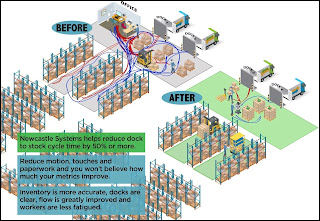Recently, one of our customers inspired us to look into a set of interesting applications: Color-On-Wheels.
 |
| Color-On-Wheels |
I’d like to describe in this post possible applications and their benefits of moving a color printer to label at the point of activity.
To prepare for this post, I spoke with Kevin Ledversis, Sales Director for Newcastle Systems: https://www.newcastlesys.com/.
Newcastle Systems is an innovator of workplace mobility solutions for many of the world’s leading retail and operations companies. As the leading provider of Mobile Workplace© solutions, Newcastle Systems provides the means to dramatically improve employee and facility productivity without major changes to your infrastructure, software or processes. A Newcastle Systems’ Mobile Workplace© facility requires less equipment and less power to do the same work as a standard workplace configuration.
According to Kevin, moving the printer to the point of activity is a key part of “lean” and “process improvement”. Kevin says “mobile work stations enable organizations to label at the point of activity. It makes no sense to use handheld computers and cell phones in manufacturing plants and distribution centers; but have printers remaining static and fixed. It’s time to change this mindset. This process improvement step saves time and reduces or eliminates labeling errors.” This process improvement idea can be used for many applications; let me discuss a few here.
To me, the most obvious color labeling application is Finish Good Labeling, especially with large items such as chemical drums or mini-bulk tanks. Typically, this type of manufacturing operation would print labels in batches and then take the labels out to the shop floor to apply them to the finished products. However, it would be easy to apply the labels to the incorrect finished goods, creating a potentially serious issue or at least a return item. By moving printing to the point of application, you eliminate the costly steps/time to and from the printer but also reduces or eliminates labeling errors. Further this process eliminates the inventory of preprinted labels kept in inventory.
Newcastle has produced an interesting case study featuring Grant Industries. Contact me to get this PDF or download the study here: https://www.newcastlesys.com/finished-goods-labeling
And if you are applying paper labels to large items, you might find this earlier post on proper label application of interest:
Another possible application for Color-On-Wheels is in Receiving. Most manufacturing facilities will print labels in a central location, and then take them to the dock for application, wasting a significant amount of time and effort. Newcastle shows this wasted time/labor in this illustration:
By adding color codes to this mix, you can improve the accuracy of both put away and picking. And with label creation software, you can automate the selection of a color for each area of the warehouse.
In addition to color codes, you can add images to the pick tickets to improve the accuracy of this error prone step. In one of my first ever posts, I wrote about Marco Specialties use of images to improve picking:
Further, you can use Color-On-Wheels application to apply replacement brand labels when OEM products are received. Relabeling while receiving reduces or eliminates potential errors later in the warehouse or during shipping.
In addition to Finish Goods and Receiving, manufacturers should consider using Color-On-Wheels for Work-In-ProcessLabeling. At some plants, work-in-process inventory/QA Testing requires labels to be applied to describe the status of the inventory (i.e. quarantined). Here is an earlier post on this application of color labels. https://colorlabelsondemand.blogspot.com/2014/09/work-in-process-color-labels.html
Typically, these labels are printed or stored in a central location and the operator walks to/from the inventory location to apply. With Color-On-Wheels, you can move the printer to the point of work to reduce or eliminate errors as well as save time and labor.
Shipping is another popular application for powered carts; printing both the shipping labels and documents.
 |
| Mobile Shipping Cart |
With mobile carts, you can process orders at the pallet, increase shipping accuracy and remove wasted time and motion. By adding color to the staging process, you can increase the accuracy of deliveries as well by color coding the shipping labels during staging:
| Color Coded Shipping Labels |
And color coded the shipping documents:
| Color Coded Shipping Documents |
A very long time ago I worked on a case study of Tubelite and their shipping process: https://colorlabelsondemand.blogspot.com/2014/09/work-in-process-color-labels.html
According to Kevin, “very few companies use color in their shop floor and warehouses. But it seems to be an easy way to add efficiencies to the processes in these important areas. Plus, you can use existing wireless networks, software and hardware (may need to add a color label printer) to enable workers and improve process flow.”
And for the cannabis market specifically, I describe how mobile work stations can improve growing operations in this recent post:
If you can imagine the possibilities of “Color-On-Wheels”, contact us to discuss how combining color label printers and a mobile power cart from Newcastle Systems can improve the operations of your business.
Guy Mikel
855-962-7670


